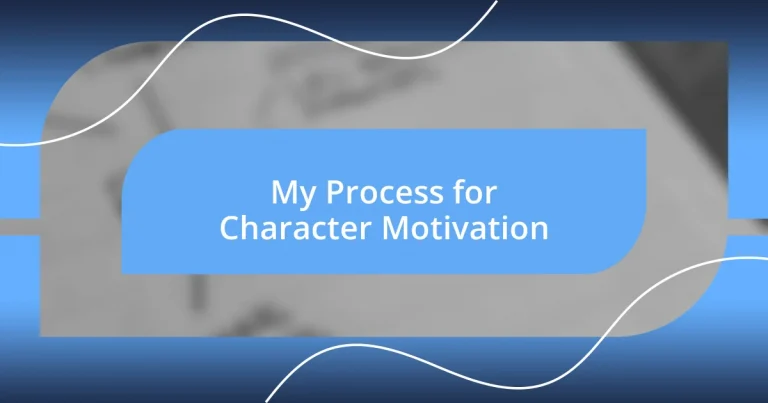Key takeaways:
- Character motivation is deeply influenced by core values, past experiences, and relationships, leading to complex and relatable characters.
- Goals drive characters’ actions and create conflict, enhancing narrative tension and allowing for personal growth.
- Relatable flaws foster empathy, making characters more authentic and allowing readers to connect with their struggles and transformations.
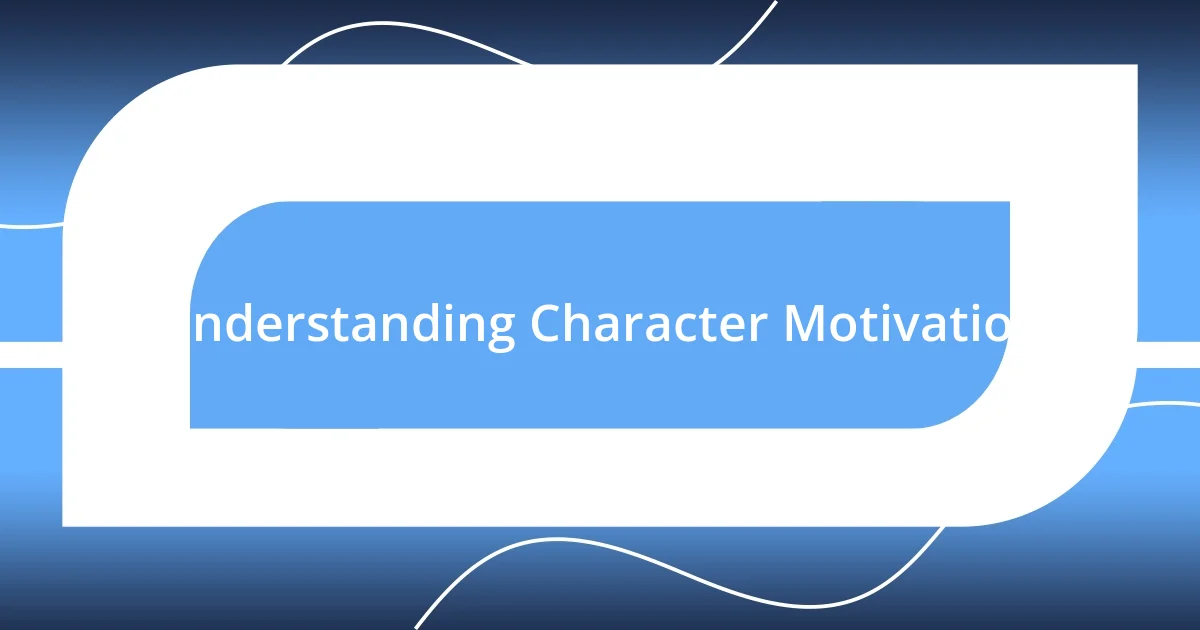
Understanding Character Motivation
Character motivation is the driving force behind a character’s actions and decisions, and understanding it can truly elevate your storytelling. I remember when I crafted a villain who became obsessed with power, and it dawned on me—what made him tick wasn’t just ambition but a deep-seated fear of inadequacy. Isn’t it fascinating how sometimes our worst traits stem from our greatest fears?
Digging deeper into motivation can reveal layers of complexity in your characters. For instance, I once worked on a protagonist whose main goal was acceptance after facing rejection in her past. This quest led me to ask myself: how do our experiences shape our desires? I found that the more I explored her backstory, the richer her motivations became, allowing readers to connect with her struggles on a personal level.
It’s essential to remember that motivations can change, influenced by events and character growth. I learned this firsthand when a turning point in my story forced a character from seeking revenge to pursuing redemption. This shift not only made him relatable but also compelled readers to reflect on the choices in their own lives. Can you think of a moment when your motivations shifted dramatically? That’s the kind of depth that makes characters resonate with an audience.

Identifying Core Values
Identifying core values is pivotal as they serve as the foundation for any character’s motivations. I once crafted a character whose unwavering commitment to honesty drove her to make tough choices, even at the cost of personal relationships. It was a reminder that values can be both a guiding light and a source of conflict; they shape not only actions but also the emotional landscape of the story.
To pinpoint a character’s core values, I find it helpful to consider these questions:
- What beliefs does the character hold that influence their decisions?
- Are there significant events from their past that solidified these values?
- How do these values conflict with the desires or goals of other characters?
- What moral dilemmas might they face when these values are tested?
- How do their core values evolve throughout the narrative?
Understanding these elements deepens the reader’s investment in the character’s journey, making it feel more authentic and compelling.
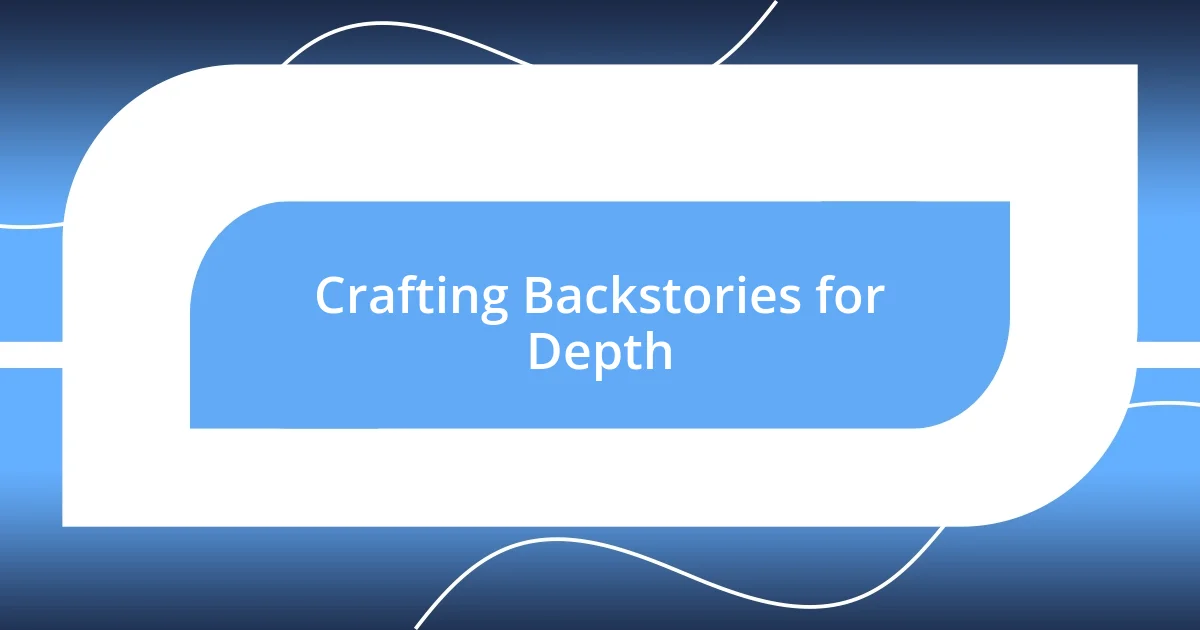
Crafting Backstories for Depth
Crafting backstories is a crucial part of giving depth to your characters. I remember developing a character who lost her family in a tragic accident; this significant event became the cornerstone of her personality. It influenced her every action, creating a rich narrative that coupled grief with resilience. It made me realize how pivotal past experiences can become within a character’s story.
As I constructed this character’s backstory, I started to weave in smaller details that reflected her upbringing and relationships. Each element, from her childhood adventures to her strained friendships, contributed layers that helped readers empathize. It’s about creating connections; I find that readers are drawn more to characters who feel real and relatable, shaped by their past. Have you ever noticed how a well-placed backstory can shift your perception of a character entirely?
I’ve also learned to balance backstory with the present narrative effectively. There can be a temptation to reveal everything at once, but I’ve found that layering in a character’s history gradually keeps the reader engaged. Think about moments in your own life that shaped who you are; isn’t it intriguing how those experiences reveal themselves over time? That’s how I aim to structure backstories—unfolding surprises that resonate with the story’s present while enriching the character’s journey.
| Backstory Element | Impact on Character |
|---|---|
| Traumatic Loss | Shapes resilience and vulnerability |
| Childhood Adventures | Inspires curiosity and impulsiveness |
| Strained Friendships | Highlights a struggle with trust |

Using Goals to Drive Actions
Setting goals is like giving characters a compass; it directs their actions and decisions throughout the story. For instance, I once created a character whose dream was to become a renowned chef. This singular ambition propelled her through numerous obstacles, from culinary school challenges to family expectations. Watching her strive toward that goal made me reflect on how powerful a character’s focus can be in shaping their journey.
I find that the specificity of a character’s goals can lead to more dramatic tension. When I crafted a character who wanted to win a prestigious art contest, I placed her in a setting fraught with competition and self-doubt. The more she chased her goal, the more her internal struggles unfolded. Have you experienced a moment where a goal pushed you to your limits? Those moments not only make a character relatable but also invite readers to connect with their own aspirations and fears.
Moreover, goals can create natural obstacles that build the narrative. I remember a character whose aim was to reconnect with her estranged brother. Every setback—like misunderstandings and past grievances—forced her to confront her own fears. This taught me that every goal should come with a cost, whether emotional or physical, which ultimately rounds out the character’s growth. Isn’t it fascinating how these struggles can lead to the most profound moments of change? I believe that layers of conflict intertwined with goals make for a more riveting story.
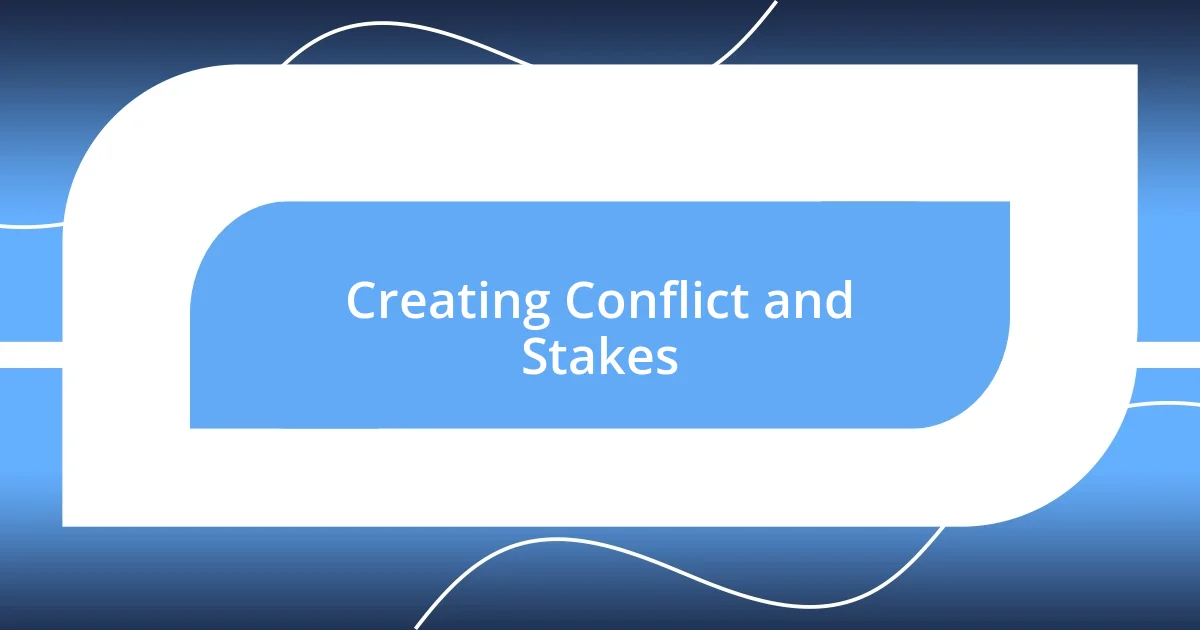
Creating Conflict and Stakes
Creating conflict is essential for driving the story forward. I recall working on a narrative where two siblings found themselves at odds over their family’s legacy. This clash not only deepened their relationship but also highlighted how differing perspectives can create tension. I always think about how conflict serves as a catalyst for growth; without it, characters would remain stagnant, and the story would lack the emotional urgency that draws readers in.
Stakes are another pivotal element in crafting conflict. In a recent project, I depicted a character on the verge of losing everything if she failed to secure a promotion at work. The fear of failure loomed over her every decision, adding layers of pressure. Have you ever felt that kind of urgency in your life? The stakes can elevate the narrative, making readers invested in the outcome. I’ve found that the more personal the stakes feel for a character, the more relatable they become to the audience.
I’ve learned that escalating the stakes requires intentional choices that shape the plot. For instance, I often use time limits to heighten tension, like a ticking clock for a character racing against time to mend a broken relationship. The countdown forces characters to confront their fears head-on, and it’s captivating to see how they react under pressure. It’s a reminder that sometimes, our greatest growth comes from the most challenging conflicts. Isn’t it fascinating to witness how characters evolve through their struggles?

Developing Relatable Flaws
When developing relatable flaws in characters, I find it crucial to draw inspiration from real life. I once created a protagonist who struggled with procrastination, a flaw that many of us can identify with. Watching her navigate through the consequences of her delays illuminated how even the tiniest imperfections can drive her story, making her challenges feel authentic. Doesn’t it make you reflect on your own habits and how they shape your decisions?
One of the most eye-opening experiences I had was building a character who grappled with insecurity. I noticed how her constant self-doubt impacted her relationships and choices. It was profound to see her journey toward self-acceptance unfold, and through her, I realized how empowering it is to portray flaws not merely as obstacles but as integral parts of personal growth. Isn’t it true that we often resonate with characters who reflect our own internal struggles?
The beauty of relatable flaws is that they create opportunities for empathy. I remember drafting a character with a compulsive need for control. While it initially seemed off-putting, her flawed attempts to maintain order in her chaotic life led to genuine, vulnerable moments. By showing her journey, I found that readers can connect deeply with her imperfections. Isn’t it fascinating how our flaws can serve as a bridge between our experiences and the characters we create?
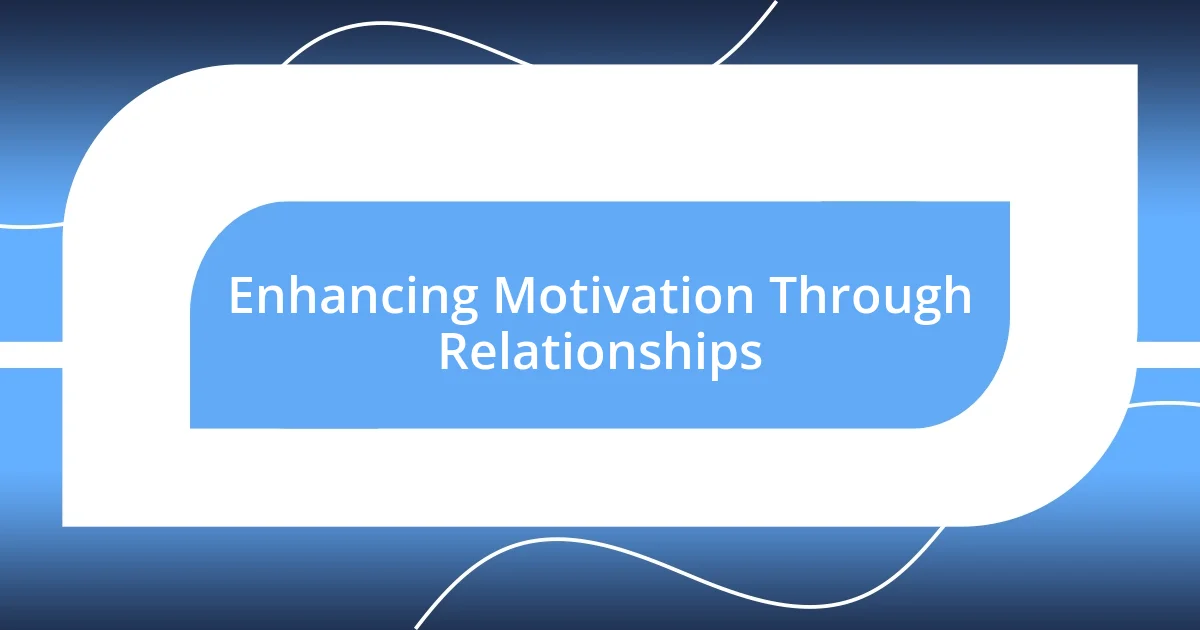
Enhancing Motivation Through Relationships
Building strong relationships between characters can truly enhance their motivation and drive the narrative forward. For example, in one of my stories, a character found solace in her friendship with a mentor who believed in her potential. Their bond not only ignited her ambition but also served as a safe space for her to express her fears. Have you ever felt how a single person can change your perspective? I certainly have, and it’s incredible to see how those connections shape the characters’ desires and decisions.
I also discovered that adversarial relationships can propel characters to action. Once, I crafted a rivalry between two coworkers vying for the same promotion. The animosity fueled their ambition, pushing them to showcase their talents in ways they never would have otherwise. It’s fascinating how relationships – whether supportive or competitive – can elevate motivations. Reflecting on my own experiences, I’m reminded that sometimes the people who challenge us can bring out our best selves.
Moreover, I find that moments of vulnerability in relationships can resonate deeply with readers. I had a character who opened up to a friend about her struggles with self-worth during a heart-to-heart conversation. This raw honesty not only solidified their bond but also inspired her friend to take meaningful steps toward their goals as well. It’s these intimate moments that remind us of our shared humanity. Isn’t it remarkable how relationships can spark motivation and personal growth, both for characters and for ourselves?












